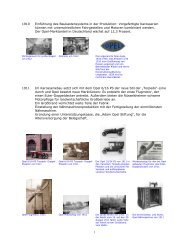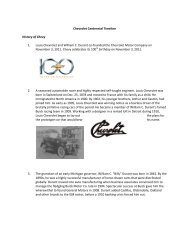You also want an ePaper? Increase the reach of your titles
YUMPU automatically turns print PDFs into web optimized ePapers that Google loves.
At the Huy Automobile Meeting in<br />
Belgium, Carl Jörns <strong>com</strong>es in first in the<br />
under 4-liter classand is declared overall<br />
winner,in October 1913.<br />
The 110 hp <strong>Opel</strong> Grand Prix race car,<br />
from 1913.<br />
The 110 hp <strong>Opel</strong> Grand Prix race car,<br />
from 1913.<br />
1914 A record-breaking race car is developed, based on the engine technology that led to the 1913 Gran Prix<br />
triumph. The cutting-edge vehicle is not only one of the first cars to feature four-valve technology – at a<br />
swept volume of 12.3 liters, its four-cylinder, 16-valve power unit is the largest displacement engine to<br />
emerge from the Rüsselsheim facilities.<br />
<strong>Opel</strong> be<strong>com</strong>es Germany’s largest automobile manufacturer.<br />
A 5/14 hp model goes into production. The hugely successful car is dubbed “Puppchen” (little doll).<br />
During WW I (1914–1918), <strong>Opel</strong> produces heavy trucks for the military.<br />
In a 260 hp, 12.3-liter race car built in<br />
1914, Carl Jörns wins first place in the<br />
over 5-liter class of the Schauinsland hill<br />
climb, in August 1925.<br />
The 5/14 hp <strong>Opel</strong>, dubbed “Puppchen,”<br />
from 1914.<br />
Carl Jörns at the wheel of a 260 hp, 12.3liter<br />
<strong>Opel</strong> race car from 1914. Beside him<br />
is his navigator, Kurt C. Volkhart.<br />
Advertisement for the 5/14 hp <strong>Opel</strong><br />
“Puppchen,” 1914.<br />
The 260 hp race car with a 12.3-liter, 4valve<br />
engine, built in 1914.<br />
The <strong>Opel</strong> 3-ton heavy truck, built in 1914<br />
to military specifications.<br />
1916 In a 18/50 hp model, <strong>Opel</strong> introduces its first six-cylinder engine, with a displacement of 4.7 liters.<br />
The 18/50 hp <strong>Opel</strong> from 1916.<br />
1919 The <strong>Opel</strong> Racetrack, located south of Rüsselsheim, is inaugurated. The oval course with banked curves,<br />
paved in concrete, is the first permanent track for racing and testing in Germany – years ahead of other<br />
well-known racetracks, such as the Berlin AVUS and the Nürburgring.<br />
The <strong>Opel</strong> Racetrack at Schönauer Hof<br />
near Rüsselsheim, circa 1931.<br />
The <strong>Opel</strong> Racetrack during the racing<br />
season, 1920.<br />
Car racing on the <strong>Opel</strong> Racetrack, circa<br />
1923.






